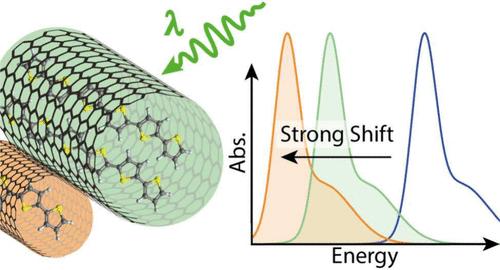氮化硼纳米管中α-硫代噻吩链的集体态
IF 4.6
2区 化学
Q2 CHEMISTRY, PHYSICAL
引用次数: 0
摘要
近距离分子的光激发可以耦合成集体态,从而产生超快辐射衰变和超辐射等现象。特别有趣的是在纳米管模板内部形成的一维分子链,在那里,纳米管将分子排列成单文件链和多文件链。与分子单体相比,所产生的集体激发具有强荧光和移位的发射/吸收能量。采用荧光光谱和远、近场吸收光谱相结合的方法研究了氮化硼纳米管中α-硫代噻吩链的光学性质。内纳米管的直径决定了被封装分子链的数量。单链α-性噻吩分子的光学吸收和发射光谱与单体发射光谱相比红移了近300 meV,这比偶极子-偶极子耦合所期望的要大得多。对于两条或多条平行链,由于链-链相互作用,集体态分裂为激发和发射通道,Stokes位移为200 meV。我们的研究强调通过一维分子晶格中分子跃迁矩的库仑耦合形成离域集体态。它们在跃迁能量方面表现出显著的可调性,这使得封装分子成为未来光电器件和分析光谱元件的有希望的候选者。本文章由计算机程序翻译,如有差异,请以英文原文为准。

Collective States of α-Sexithiophene Chains Inside Boron Nitride Nanotubes
The optical excitation of close-by molecules can couple into collective states giving rise to phenomena such as ultrafast radiative decay and superradiance. Particularly intriguing are one-dimensional molecular chains that form inside nanotube templates, where the tubes align molecules into single- and multifile chains. The resulting collective excitations have strong fluorescence and shifted emission/absorption energies compared to the molecular monomer. We study the optical properties of α-sexithiophene chains inside boron nitride nanotubes by combining fluorescence with far- and near-field absorption spectroscopy. The inner nanotube diameter determines the number of encapsulated molecular chains. A single chain of α-sexithiophene molecules has an optical absorption and emission spectrum that is red-shifted by almost 300 meV compared to the monomer emission, which is much larger than expected from dipole–dipole coupling. For two or more parallel chains, the collective state splits into excitation and emission channels with a Stokes shift of 200 meV due to the chain–chain interaction. Our study emphasizes the formation of a delocalized collective state through Coulomb coupling of the molecular transition moments in one-dimensional molecular lattices. They show a remarkable tunability in the transition energy, which makes encapsulated molecules promising candidates for components in future optoelectronic devices and for analytic spectroscopy.
求助全文
通过发布文献求助,成功后即可免费获取论文全文。
去求助
来源期刊

The Journal of Physical Chemistry Letters
CHEMISTRY, PHYSICAL-NANOSCIENCE & NANOTECHNOLOGY
CiteScore
9.60
自引率
7.00%
发文量
1519
审稿时长
1.6 months
期刊介绍:
The Journal of Physical Chemistry (JPC) Letters is devoted to reporting new and original experimental and theoretical basic research of interest to physical chemists, biophysical chemists, chemical physicists, physicists, material scientists, and engineers. An important criterion for acceptance is that the paper reports a significant scientific advance and/or physical insight such that rapid publication is essential. Two issues of JPC Letters are published each month.
 求助内容:
求助内容: 应助结果提醒方式:
应助结果提醒方式:


